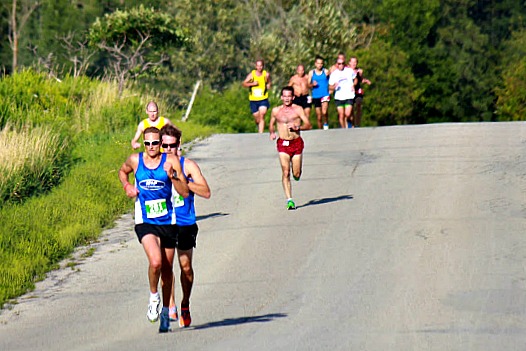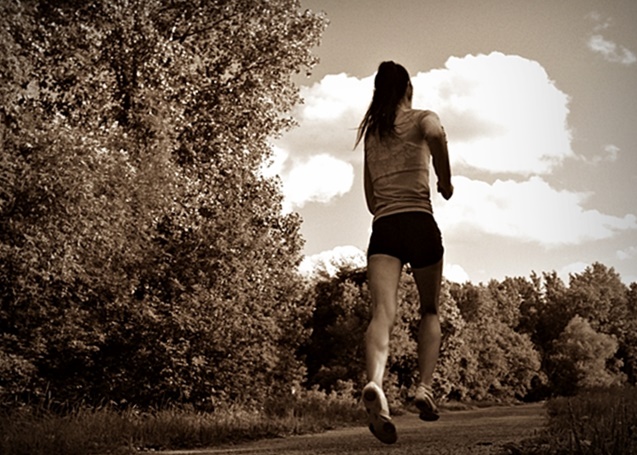Uphill running is speedwork in disguise in that it gives you the strength you need to pull through a marathon. Hill workouts are pretty much the gold standard for improve running performance. But, did you know that repeatedly jogging back down the hill in between sets insidiously sabotages the endurance benefits of hill workouts?
Uphill Running Workouts – Something to Keep in Mind
Jogging Downhill Hurts & Compromises Efficiency
A study by Buaman et al. was the first study to report that jogging downhill negatively affected running economy.
The study found that low-intensity downhill running equivalent to jogging back down the hill between sets of uphill running intervals, resulted in leg strength deficits that lasted two days.
In the study, an 18% strength deficit was observed immediately after repetitive bouts of jogging downhill and remained reduced by 10% two days later!
Moderate leg soreness also occurred two days after jogging downhill. Finally, not only did running economy plummet after two days of downhill jogging, maximal quad strength reduced also. Why did this happen?
Jogging Downhill with the Brakes On
The troubling scenario with repeatedly jogging downhill is the urgency to brake to prevent rapid speed increase and injury. This is hugely debilitating on the quads.

During the gait cycle when running on level surfaces, the quad muscles undergo eccentric contractions to decelerate the leg. Conversely, jogging downhill causes these eccentric contractions to be exaggerated.
- Too much eccentric contractions increases torque and mechanical stress on the muscle fibers.
- Warren et al. reported that this high mechanical stress leads to excitation-contractions or hyper-contractions of the muscle, resulting in disruptions in muscle function and damage to the muscle’s force bearing structures.
As mentioned above, jogging downhill resulted in leg soreness that lingered for two days. The researchers found that downhill jogging led to a significant increase in serum creatine kinase (CK) levels in the blood, an indicator of inflammation.
The researchers concluded that low-intensity downhill running was enough to provoke muscle injury and subsequent physiological and mechanical changes during submaximal running. In other words, if you spend a lot of time jogging downhill during a run, you may feel tired on your next run, unless you rest for at least 3 days after running downhill, but who wants to do that?
Walk Down the Hill Between Sets
An effective intervention to prevent injury and fatigue during hill workouts is to walk back down the hill between sets. However, if you want to be better prepared to run downhill, you need to run faster and with good form.
More From Run Forefoot:
Make learning forefoot running easier by reading books on the barefoot running technique.
Learn how NOT to swing your arms when running.
Recap on what a proper forefoot strike looks like.
Proper technique starts with proper footwear! Here are my reviews on the best barefoot running shoes for forefoot runners.
Feel sluggish in the morning before a run? Spike your water with these energy-boosters.
References:
Bauman et al. Muscle Injury after low-intensity downhill running reduces running economy. J Strength Cond Res, 2014; 28(5):1212-1218.
Braun, WA and Dutto, DJ. The effects of a single bout of downhill running and ensuing delayed onset of muscle soreness on running economy performed 48 h later. Eur J Appl Physiol 90: 29–34, 2003.
Chen, TC, Nosaka, K, Lin, MJ, Chen, HL, and Wu, CJ. Changes in running economy at different intensities following downhill running. J Sports Sci 27: 1137–1144, 2009.
Chen, TC, Nosaka, K, and Tu, JH. Changes in running economy following downhill running. J Sports Sci 25: 55–63, 2007.
Child, R, Brown, S, Day, S, Donnelly, A, Roper, H, and Saxton, J. Changes in indices of antioxidant status, lipid peroxidation and inflammation in human skeletal muscle after eccentric muscle actions. Clin Sci (Lond) 96: 105–115, 1999.
Enoka, RM. Eccentric contractions require unique activation strategies by the nervous system. J Appl Physiol (1985) 81: 2339–2346, 1996.
Komi, PV and Viitasalo, JT. Changes in motor unit activity and metabolism in human skeletal muscle during and after repeated eccentric and concentric contractions. Acta Physiol Scand 100: 246–254, 1977.
Warren, GL, Ingalls, CP, Lowe, DA, and Armstrong, RB. What mechanisms contribute to the strength loss that occurs during and in the recovery from skeletal muscle injury? J Orthop Sports Phys Ther 32: 58–64, 2002.
Bretta Riches
BSc Neurobiology; MSc Biomechanics candidate, ultra minimalist runner & founder of RunForefoot. I was a heel striker, always injured. I was inspired by the great Tirunesh Dibaba to try forefoot running. Now, I'm injury free. This is why I launched Run Forefoot, to advocate the health & performance benefits of forefoot running and to raise awareness on the dangers of heel striking, because the world needs to know.
Latest posts by Bretta Riches (see all)
- Cushioned Running Shoes Found to Be Bad for Ankles - 23/04/2024
- Forefoot Running and Achilles Pain - 19/04/2024
- Does Foot Strike Really Matter in Running? YES! - 17/04/2024


Leave a Reply